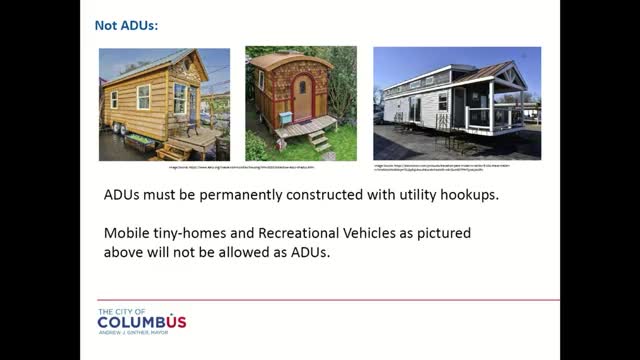Columbus Council Proposes New Regulations for Accessory Dwelling Units Approval Process
July 23, 2025 | Columbus City Council, Columbus, Franklin County, Ohio
Thanks to https://workplace-ai.com/ , all articles about Ohio are free for you to enjoy throughout 2025!

This article was created by AI using a video recording of the meeting. It summarizes the key points discussed, but for full details and context, please refer to the video of the full meeting. Link to Full Meeting
As the meeting unfolded, it became clear that the city is taking significant steps to clarify and expand the regulations surrounding ADUs. One of the key points emphasized was the exclusion of mobile tiny homes and recreational vehicles from the ADU category. Officials stressed that the focus remains on permanent structures, ensuring that the integrity of residential neighborhoods is maintained.
Data presented during the hearing revealed that from 2019 to 2023, Columbus approved 44 ADUs, all of which were detached from the primary dwelling. Notably, 80% of these units were second-story garages, while the average size of these ADUs was 722 square feet, significantly smaller than the principal homes they accompany. This data underscores a trend towards compact living solutions that align with urban development goals.
The proposed code changes aim to simplify the process for homeowners looking to build ADUs. Currently, the variance process can take three to six months, creating a barrier for many potential projects. By revising the code, officials hope to streamline approvals, allowing homeowners to focus on design and utility considerations rather than navigating lengthy bureaucratic hurdles.
New provisions would allow ADUs in all residential districts, with specific size and height restrictions to ensure they remain subordinate to the main dwelling. For instance, an ADU cannot exceed 1,000 square feet or 65% of the principal building's floor area. Additionally, the height of these units would be capped at 25 feet, promoting a harmonious aesthetic within neighborhoods.
The council also discussed the implications for utility services, with considerations for sub-metering to ensure fair billing for ADU occupants. This aspect is crucial, especially if the ADUs are intended for rental purposes, as it would help clarify utility costs for residents.
As the meeting concluded, the atmosphere was one of cautious optimism. The proposed changes not only aim to increase the availability of affordable housing options but also reflect a growing recognition of the need for flexible living arrangements in urban settings. With the potential for quicker approvals and clearer guidelines, Columbus is poised to embrace a future where ADUs play a vital role in addressing housing challenges. The council's commitment to revising these codes signals a proactive approach to urban development, one that could inspire other cities facing similar housing dilemmas.
Converted from Council Public Hearing: Accessory Dwelling Unit ADU Code 7/22/25 meeting on July 23, 2025
Link to Full Meeting
Comments
View full meeting
This article is based on a recent meeting—watch the full video and explore the complete transcript for deeper insights into the discussion.
View full meeting
